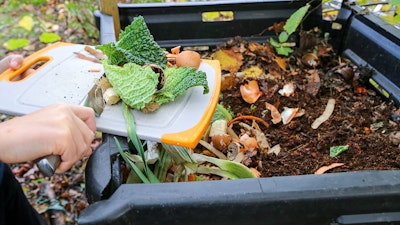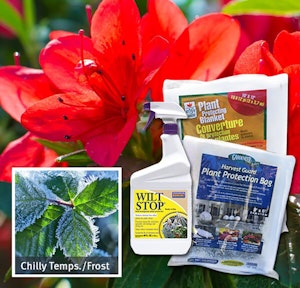 Back to the Be Inspired Blog
Back to the Be Inspired Blog

Winter Gardening: How To Protect and Prepare Plants
The cold weather is approaching and that means there is still work to do in the garden; you didn’t think you could hang up your gloves and tools, did you? Maintenance for your indoor and outdoor plants is critical for their wellbeing and to set you up for success next year.
Keep reading for tips on how to protect your indoor plants during the winter months and ways to help your outdoor garden continue to thrive in the cooler weather.
5 Winter Indoor Gardening Tips
Even if it’s cold outside, you can still surround yourself with plants. Here are five things you can do to improve the health of your indoor plants.
- Keep Temperatures Up

While your houseplants need and like the light, think about where you put them in your home; during the winter months, houseplants that are placed too close to windows and doorways may get too chilly from those drafty locations. The opposite is true as well - most houseplants can’t tolerate much of a temperature change and if they are sitting too close to a vent or heater, they may experience dryness or poor circulation. Like us, houseplants thrive at temperatures between 65º and 75º F.
- Keep Them Clean
Simply dusting, spraying or wiping down your houseplants will relieve that stress weighing them down. A healthy plant is less likely to attract bugs; which is great since they are indoors.
- Dip Their Roots and Get Out
Houseplants that sit in water for more than 20 minutes or so can endure salt burn on their delicate roots. It’s recommended to water thoroughly and discard excess water at the basin.
- Give Them a Little Extra Sunshine

Since the days are shorter during the winter months, your plants may need a little more direct light (maintaining that reasonable distance from cold windows and vents). Try turning them a quarter turn each week to make sure they grow evenly; don’t make them work too hard for it. It also can be helpful to purchase a small grow light to give them all the light rays they need in the winter.
- The Right Food
Fertilizing your houseplants during the winter months is still a great idea, but make sure you use the right kind. Feed them with a time release fertilizer like Osmocote Plus. After one application (based on the size of the container), each time you water, the fertilizer is released into the soil and will feed your houseplant for up to 6 months. Water soluble fertilizers aren’t recommended during the winter season because you have to water and then water again; if applied when plant is dry, it could burn the roots and/or plant.
4 Winter Outdoor Gardening Tips
Not only is the hard, cold ground damaging to your outdoor garden, other elements of winter can wreak havoc on your yard. Here are four tips from Savvy Gardening for working on your plants during the cold and frozen months.
- Protect Your Plants

Road salt can ruin plants and soil. In areas of heavy salt use, soil salinity rises and vital soil life can be impacted, not to mention all those tender plant roots and evergreen foliage that simply can’t tolerate being exposed to salt on a regular basis. Protect roadside plantings from salt spray with a shield of landscape fabric placed into a fence with wooden stakes.
- Get Rid of Dead Trees
While you may not be able to do this yourself, it’s important to do. Winter is a great time to have a troublesome or dangerous tree removed from your property. With no foliage to cloud their work, many arborists are more than happy to cut down trees that have to go during this time of year.
- Build a Compost Bin

Grab some extra wooden pallets and get building! Once you have your pallets, use them to build one or more three-sided bins. Use extra-large plastic zip-ties to fasten them together, giving each bin a back and two sides. Locate your new composting system in a mostly sunny site, and you’ll be up to your elbows in ‘black gold’ before you know it.
- Prepare for a New Garden
Are you planning a new garden bed for next season in an area where grass and weeds are currently growing? Make it easy on yourself by starting the project right now, yes now. First, place a thick layer of newspaper or cardboard over the area, then pile on alternating layers of organic material like compost, leaves, pine needles, untreated grass clippings, and straw. In the spring, the grass and weeds underneath the pile will be dead, and your new garden bed will be ready to plant!
Protecting Your Winter Garden
One of the most important thing you can do in your garden during the cooler months is to go into protect mode. Your fruit trees can become susceptible to peach leaf curl, blight and other damaging diseases. And your delicate outdoor plants, such as hibiscus, azaleas, gardenias and bougainvillea, can perish during a hard frost.
Our recommendations for protecting your fruit trees: Once your fruit trees fall dormant (leafless), you will want to spray 3 separate times during the season, a minimum of 30 days apart.
- 1st Application – Thanksgiving
- 2nd Application – New Year's Day
- 3rd Application – February 1st
We Recommend: Bonide Copper Fungicide - Organically treats brown rot, black spot, blotch, downy and powdery mildew, fire blight, leaf spot, peach leaf curl, rust and scab. Bonide All Seasons Horticultural Spray Oil - The organic option to all insect pests. Use superior type paraffinic oil as a growing season spray, dormant spray (no leaves) or delayed dormant (green tip) spray. It controls overwintering eggs of insects such as aphids, leaf roller, codling moth and more and can be used on fruit trees, shade trees, shrubs, ornamentals, roses and vegetables. It’s safe and pleasant to use.

When spraying, follow these helpful tips:
- Apply Copper Fungicide a minimum of 24 hours before oil treatment or up to two weeks after
- Choose a day without wind
- Use it early in the day, 24 hours or more before expected rain
- Sprays should be reapplied after significant rains
- The last spray should be early February, around the Super Bowl!
- ALWAYS do it before bud break - NEVER after (Bud-break usually occurs mid-Feb. when temperatures begin to warm)
To download a pdf version of this information and additional tips on fruit trees, click here.
Recommendations for protecting your delicate plants during cooler temps and potential frosts:
Thankfully in this day and age, we hear about potential frost warnings in our areas before it's too late. There are even apps, such as ColdSnap, that can alert us in advance. The importance then falls on the types of products we keep on hand to protect during the cooler temps. For the greatest protection against frost, we recommend that you use a combination of Wilt-Stop and a frost protection blanket or bag. Be sure to pay special attention to your sub-tropical plants such as hibiscus, canna, bougainvillea and some varieties of jasmine. They are the most susceptible to damage if not protected. And at a minimum, you should water all of your plants when a potential frost is expected. A well hydrated plant is less likely to suffer from cold damage. 
Gardeneer Harvest Guard Plant Protection Bag - A cold either protective cover for shrubs and potted plants. It helps to protect shrubs and smaller trees from cold weather and prevents against frost, snow and ice from damaging or overloading branches.
Easy Gardener Plant Protecting Blanket - This medium weight fabric provides 6 to 8 degrees of frost protection. Bonide Wilt Stop - An anti-transparent plant protector. It reduces moisture loss when plants are under stress. It also prevents winter kill, wind burn, sunscald, salt damage and drying out, and helps reduce transplant shock.
If you have questions about these products or additional measures you can take to protect your garden during cooler months, stop by your local SummerWinds Nursery to speak with one of our Trusted Garden Advisors! At SummerWinds, We Guarantee Success!
Gardening Through the Winter Just because the sun in gone, that doesn’t mean there still isn’t work to be done in the winter. Use our tips to keep your indoor plants healthy and to keep your outdoor gardens in good shape as well. Visit your local SummerWinds Nursery for professional tips and advice from our expert gardeners.

